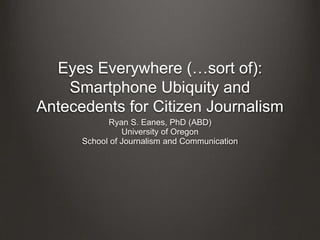
Eyes Everywhere (...sort of): Smartphone Ubiquity and Antecedents for Citizen Journalism
- 1. Eyes Everywhere (…sort of): Smartphone Ubiquity and Antecedents for Citizen Journalism Ryan S. Eanes, PhD (ABD) University of Oregon School of Journalism and Communication
- 3. Smartphones, Smartphones, Everywhere 64% of American adults now own a smartphone Up from 35% in 2011, up from 56% (!) in 2013 Hundreds of millions of active smartphones Small but growing portion (7%) do not have broadband access at home and have few, if any, options for getting online other than their smartphones Becoming increasingly important for low income individuals/families (<$30k/year); 13% rely on smartphones for Internet access Prices have fallen substantially enough that there is no longer a significant barrier to smartphone ownership, especially with prepaid options Source: Pew Research Center (2015)
- 5. A Camera That Happens to Be a Phone?
- 7. Eric Garner
- 10. What prompts citizen journalism? Perhaps the answer lies in innate psychological differences…
- 11. Something in the Personality? “Big Five” (“CANOE”) most common, and heavily researched/used in psychological studies Conscientiousness Agreeableness Neuroticism Openness Extraversion HEXACO structure receiving increasing attention Honesty-Humility Emotionality Extraversion Agreeableness Conscientiousness
- 12. Proposed Research Design Survey “Have you ever used your smartphone to record or report breaking news that you witnessed?” Either a Big Five or HEXACO assessment Comparison of the two groups—is there a difference that can be attributed to differences in personality structure?
Hinweis der Redaktion
- Show of hands, how many people in this room have a device that looks something like this? Keep holding your hands up if you’ve had more than 1… more than 2… more than 3… …did anyone have any of the predecessors (Palm, Handspring, BlackBerry)?
- This is from the latest Pew Research Center study on smartphones, which was just released on the 1st of this month.
- Even the most clueless among us are aware of the power that the camera contained in our phone holds, including Gale Beggy (how many are familiar with CollegeHumor.com?), the “chief of technology” for CollegeHumor.com, here talking about the iPhone 4S.
- In fact, some makers of phones are going so far as to suggest that the camera is the most important feature of the device.
- So I propose that we are moving from a state where the “eyes” are not solely controlled by the state (consider the prevalence of CCTV), but one where citizens also have the power to record events and fight back, if need be.
- Perhaps the most dramatic recent example of this was the killing of Eric Garner in Staten Island, who was put into an illegal chokehold by a police officer, and was ruled a homicide by the coroner. The entire altercation was captured on video and it went viral quickly afterwards, largely contributing to the ongoing questions we have regarding police brutality in this country, particularly aimed at African-Americans.
- Even so, we know that there is a phenomenon known as the bystander effect. Consider the case of Kitty Genovese, who was stabbed to death in 1964; purportedly, three dozen people witnessed this happening but did nothing, and while this account has been criticized as inaccurate, we know that there is indeed something known as the bystander effect or “diffusion of responsibility,” where people are less likely to take action when other people are present. We assume someone else will take charge.
- But in a digital era, we know for a fact that people record things and upload them to YouTube or send them to other media channels. But not everyone does this. If they did, we would be awash in stories, and this isn’t the case.
- Pew says that 68% of smartphone owners use their devices to follow breaking news, and that 67% share pictures and videos (though only 35% say that they do this “frequently”).
- This is where I started to wonder whether personality traits and innate structures may lead some people to be more likely to take on the mantle of “citizen journalist” than others, and so what I propose is using one of these assessments to compare the personalities of people who both do, or have, reported news using their smartphones, to those that do not or would not.
